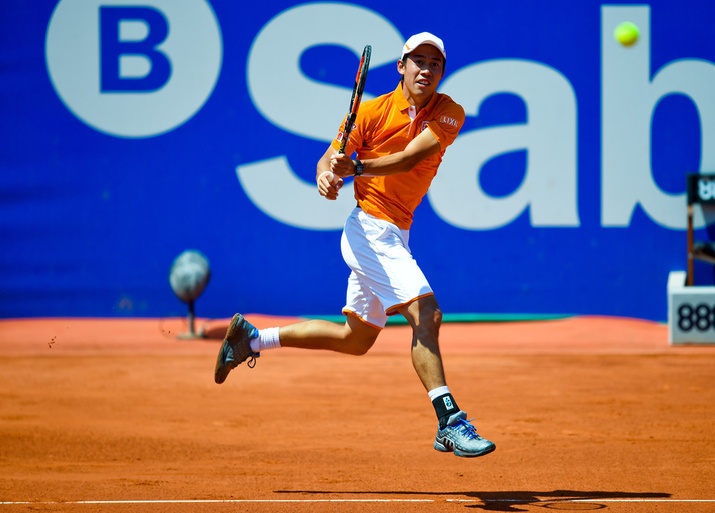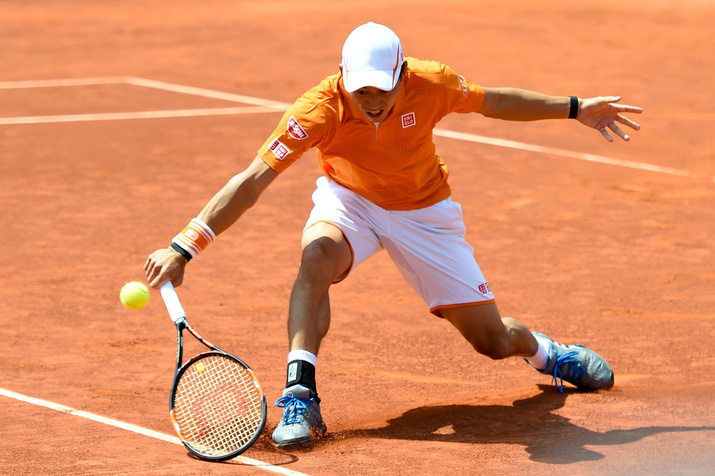Don't miss any stories → Follow Tennis View
FollowNishikori Extends Clay Success in Barcelona
Digging out an insightful comment in English from Kei Nishikori may still be no less difficult than attempting to draw blood, water, and edible food from a stone, but at least the Japanese star doesn’t lie. When asked about his continuing conquests on clay, he hardly offered the surface a ringing endorsement.
“I don't know why, but I'm getting really good on clay. These past 2, 3 years I’m getting a lot of confidence. I feel like I can play really good. Maybe it's not my favorite (surface), but I keep winning,” he said, chuckling.

By now, the effectiveness of Nishikori’s work on clay is beyond any inkling of doubt. His victory over Benoit Paire in today’s semifinal in Barcelona marked his 14th win in a row in the tranquil surroundings of Barcelona’s center court. His final hurdle against Rafael Nadal, the man who has won this tournament nine times, will provide Nishikori with the opportunity to become only the third active man to three-peat a 500+ on clay.
Whenever the ‘Project 45’ graduate spoke of clay during his first victorious forays in 2014, as the tennis world squinted and adjusted their eyes to his newfound clay skills, Nishikori would constantly speak of his need to be aggressive, to dominate points, and to finish them on the surface. This is hardly a new concept, and it has become a cliché in a sport where even the Caroline Wozniackis of the world claim to be following identical blueprints.
But Nishikori doesn’t lie, and it always has been clear that he knows he can’t survive on clay without playing aggressive tennis. It isn’t merely the sense of obligation to play aggressively - as on hard courts - but rather the understanding that any other manner on clay is completely incompatible with winning matches. He has no other choice, and so there is only one outcome.
When Nishikori sits back on clay, his spinless, weightless rally ball sits up on the slow surface for opponents to do whatever they please with it. But the clay courts have embraced his aggressive, hookier run-around forehand like a long lost brother, and the imagination with which he constructs his aggressive points - creating acres of space with his talent for angles, taking the ball early by directing traffic to all spots around the court, and periodically throwing in drop shots - are rewarded fully on clay.
Alongside the 13 victories that preceded it, this too was the recipe of Nishikori’s victory against Paire on Saturday. With two consecutive defeats to the Frenchman last year still fresh in his mind, Nishikori took control from the moment he stepped on the court. After those two failed attempts, he finally unleashed a barrage on Paire’s weaker groundstroke wing that should always be compulsory against the forehand-challenged Frenchman.

But in the bigger picture, Nishikori simply controlled the flow of traffic from the very beginning, completely rendering the Frenchman’s own aggressive instincts useless. As early as five games in, when Paire gave away the first break as he resorted to a desperate drop shot attempt following a return winner and a brilliant, bullying first-serve return from Nishikori, the match was effectively over.
Still, the only relevant event this week will come tomorrow when Nishikori and his two-and-a-half-year lease of the Barcelona event meet the man who owns the deeds to the place. Nishikori insisted afterward that he feels closer to the top players than ever, but in the 18 months since his US Open finals appearance, the results emphatically show that he has been moving further away. After being the leading contender behind the closed ranks of the top five, over the past 12 months - with the exception of his anomalous and futile fightback against Murray this year during the Davis Cup - Nishikori has managed to capture only two sets in eight matches against those players.
Thus, with a newly confident Nadal, this final between the two kings of Barcelona brings Nishikori an opportunity to present himself as a legitimate contender ahead of the meat of the clay season, rather than as a player ready to beat those below him but increasingly prone to being picked off by the elite. Nadal may be confident, but his serve remains vulnerable, and his forehand still misfires under sufficient pressure, as it did for periods against Fognini in their quarterfinal. It’s up to the two-time defending champion to inflict the necessary pressure and see how far he can push the eight-time champion. Nishikori doesn’t lie, and neither will the final result.










